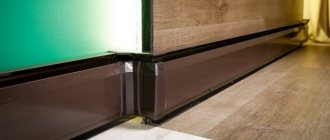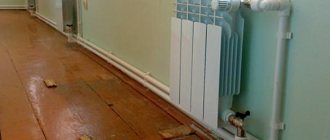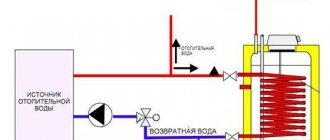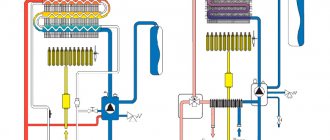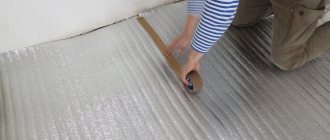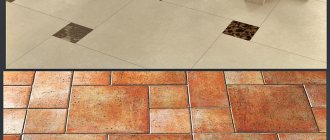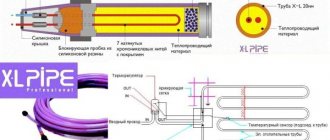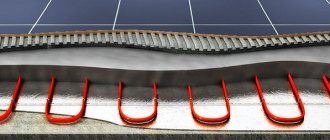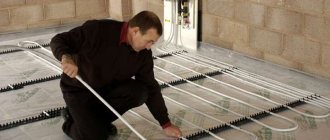Design and principle of operation of a warm baseboard
We can say that a warm baseboard is a fundamentally new approach to the issue of heating an ordinary apartment or private house. This system received this name due to its visual similarity to the usual baseboard and its compact size. Externally the design is:
- an aluminum box consisting of three walls - top, bottom and front;
- The thickness of the box is no more than 3 cm;
- The height of the front panel ranges from 10 to 24 cm;
- For decorative purposes, the ends of the box are closed with special plugs;
- Inside the box are heating elements that are attached to the wall using mounting brackets.
Depending on the heat source used, a warm baseboard can be electric or water. By the way, outwardly they are practically indistinguishable. The operating principle of a warm baseboard differs significantly from the operating principle of conventional heating devices - convectors or heating radiators.
Anyone who is more deeply interested in economical ways to heat their home knows that the same batteries heat the room by convection. That is, the heat emanating from their surface heats the air. In this case, hot air rises up to the ceiling, where a thermal cushion is created, which displaces cold masses down. In rooms with low ceilings, this difference is not very noticeable and, in principle, comfortable conditions are created. But in rooms with high ceilings it is necessary to use forced ventilation, which will help mix air masses of different temperatures and warm them up as quickly as possible. In this case, most often in the corners of the room the air will still remain cold. Thus, warming up the entire volume of air in a room requires higher temperatures and longer times. Heat loss is 20-30%.
Surely, when using electric oil convectors, you noticed that next to the heater you feel warm, even hot, but literally a meter away from it the air is cold. In addition, the air becomes dry and foreign odors can often be detected.
The operation of a warm baseboard is based on gradual, uniform heating of adjacent walls and floors. Heating the air by convection uses no more than 30% of the radiated heat. Warming begins from the lower layers of air. The heat then slowly “creeps” up the walls, heating their surface in the process. Thanks to this, it became possible to achieve the same temperature throughout the entire height of the room.
A person begins to receive heat from the surface of the walls, which, after heating to a given temperature, literally radiate it.
This method of heating a home has been used in very ancient times. At that time, a system of cavities was specially provided in the walls of houses through which hot steam was supplied. It is also noteworthy that, rising along the walls, the hot air practically does not mix with the surrounding air, thus creating a thermal curtain. This is especially true when heating rooms with panoramic windows.
Cold air leaking through unsealed joints is simply cut off and does not cool the room. Heat loss when using warm baseboards is only 5%. Needless to say, this method is economically beneficial? It has been proven that when walls are heated to a temperature of 37-38°C, a person becomes warm and comfortable even though the air temperature in the room is 16-17°C. A warm baseboard can be used as a complete heating system. Then you need to install it around the entire perimeter of the room. It can also be used as an additional source of heat in places where installing conventional radiators is impossible. For example, for heating a loggia with French glazing.
Then the baseboard should be placed along the double-glazed windows.
Many people are interested in the question : is it advisable to place a plinth around the entire perimeter of the room if there are large-sized furniture along some walls? Considering the principle of its operation and the fact that the rising heat is more aimed at warming the walls, rather than the surrounding air and adjacent objects, we can say that the furniture will not interfere with the full operation of the system. In addition, heating elements have a low-temperature operating mode. They do not heat up above 60°C and cannot harm furniture or any type of floor covering. Thus, we can conclude that a warm baseboard is a safe and economical source of heat.
System principle
The principle is very similar to the “warm floor” system. Only, if in the first case the heat comes directly from the floor, then in the baseboard heating system the walls are more involved. Heat, transmitted from the heaters, “creeps” along the walls, thereby creating a thermal curtain around the entire perimeter of the room, preventing the apartment from cooling. Naturally, this same heat warms up the interior volume of the room. In this way, we “kill” two birds with one stone: we create a favorable microclimate in the apartment without drafts and pockets of cold and warm up the room. And the walls themselves will be warm and pleasant.
Electric warm baseboard
Electric models of warm baseboards are more popular than water ones. This is due to a simpler installation method and the fact that electricity is available even in remote areas. The principle of operation of an electric heated baseboard is similar to the principle of operation of the “warm floor” system. Let's take a closer look at the design:
- Inside the box you can see two copper tubes with a diameter of 13 mm and a wall thickness of 1.5 mm. The tubes are tightly fitted onto brass ribs. The bottom tube houses a low-temperature dry heating element;
- Inside the top tube is a heat-resistant silicone insulated electrical cable that provides power to the heater;
- Copper is an excellent heat conductor. The front panel of the plinth is made of aluminum, which is also a good conductor. By combining these two alloys, it became possible to achieve maximum heat transfer;
- Additionally, the system is equipped with a thermostat and temperature sensor . It was with the help of a thermostat that it became possible to achieve significant savings. Manufacturers offer models of different prices, respectively, with different capabilities. There are thermostats that allow you to set the desired temperature several days in advance. Simpler models require constant manual adjustment.
It cannot be said unequivocally that some models are better than others. The choice should be based on your financial capabilities and whether you are willing to constantly adjust the sensor manually. The thermostat is connected to a temperature sensor, which controls the operation of the entire system. To achieve the most correct indicators, the sensor should be placed at a height of 130-150 cm from the floor level. When the temperature in the room reaches the set point, the thermostat will turn off. And it will turn on again when the temperature drops to the lower set temperature.
The length of one module of an electric warm baseboard can be from 0.7 to 2.5 m. This makes it possible to dial a heating circuit of varying power depending on the size of the room. On average, 1 linear meter of baseboard produces from 180 to 280 W of heat. In order for the operation of the electric baseboard to be safe, it should be used only if there is powerful, new electrical wiring. Manufacturers claim that you can simply plug the baseboard into an outlet. But for reliability, it is still recommended to install a separate line that will go directly to the meter and install a separate machine on it.
Reviews from other CIS countries
I. P. Ostrov, Kharkov
Before I buy something, I follow an ironclad rule: I definitely study people’s reviews and get acquainted with the opinions of experts. Honestly, I don’t understand those who speak poorly of this technology. I've been using it for over a year now and don't see any significant drawbacks. I installed it myself. I simply read the instructions, had a good head on my shoulders, and patience too, and got to work. Skirting boards do not take up much space, which is important for my small room. I calculated that one more season and such a system would completely pay for itself. Buy thermal skirting boards and you will be satisfied with your choice.
Alla, Odessa
I heard a lot about this technology and, as they say, became a victim of marketing. I fell for the advertisement and decided to install a warm water baseboard. Disappointed. Not at all what I expected. I had to start rearranging the furniture. Now the situation in the room looks somewhat chaotic.
Warm baseboards are not able to provide warmth in the house. I still have to use radiators (it’s good that I didn’t decide to turn them off!). After some time, I came to the conclusion that it was better to abandon skirting boards and choose some alternative option. I don't recommend it.
Alexey, Gomel, Belarus
I read a lot about warm water baseboards and decided to install them. I have an old battery under the window, it doesn’t look very aesthetically pleasing, since it’s not even in a niche. A warm baseboard was laid along the entire length of the wall. It feels like nothing has changed, the temperature in the room is the same. But now the Soviet cast-iron heater is no longer an eyesore.
Water warm baseboard
The operating principle of water models is similar to the operation of water boilers. design differs significantly from electric ones:
- The water baseboard does not have heating elements. It involves the use of already heated coolant. Its role can be either ordinary water or antifreeze;
- The heated liquid flows through cross-linked polyethylene tubes located inside the box;
- There are two tubes inside, located one above the other. In this case, coolant is supplied through the upper tube, and it is taken in through the lower tube;
Sufficient pressure is required to circulate fluid through the system. Therefore, circulation pumps are used to organize water heating in private homes. With their help, coolant under a certain pressure passes through the distribution manifold and is supplied through tubes to the heating modules.
The water modules are connected to each other using special tubes made of cross-linked polyethylene. If the connection point is at a corner, then use polyethylene or corrugated corner joints. The latter are usually made of steel or copper. It is worth noting that for proper operation of water circuits, their length should not exceed 12.5 meters. Some manufacturers allow a length of up to 15 m. If this length is not enough to heat the entire room, it is recommended to equip two separate heating circuits.
The room temperature when using a warm water baseboard can be adjusted either manually on the distribution manifold, or, as in the previous version, using room thermostats. They, in turn, control the servos of the distribution system valves.
As you can see, organizing a water heating system requires much more expense than an electric one. In addition to installing the pump and collector, it is necessary to ensure proper storage conditions for the coolant and its cleaning. This is why electric models are often preferred.
As for connecting a warm baseboard within an ordinary city apartment . It is possible to connect the baseboard to the central heating network. In this case, the danger is the temperature of the coolant and water hammer, which are often present when starting the system. The water temperature in the batteries is 85-90 degrees, and its pressure can reach 9 atmospheres or more. These indicators can have a detrimental effect on the design of a warm baseboard.
Our task is to minimize their impact by physically separating the internal heating circuit from the centralized network.
- This can be done realistically using heat exchangers. That is, devices that, with the help of heat-conducting plates, will take on excess heat from the coolant of the centralized network and transfer the required amount to an internal independent circuit.
- In typical dwellings, riser wiring is used. In this case, each room can have one or two pipe risers. In this case, the water baseboard is directly connected using copper fittings by soldering or plastic pipes complete with fittings. In this way, restrictions on the temperature and pressure of the coolant are removed.
- Thermal valves are installed at the connection points to the riser.
Types of electric skirting boards
The issue of cost is one of the main ones that worries buyers of electric baseboard convectors not only in Moscow. Their prices largely depend on the type of construction. Today, baseboard convectors are available in two versions :
- Electric. It uses dry heating elements installed in copper tubes. This design provides more efficient and safe heating of the room. To connect such a system, you will have to lay powerful electrical wiring into the room. If necessary, you can achieve a more economical operating mode by additionally installing a thermostat.
- Water. The main working element is the heating boiler. According to the principle of operation, such a system is very similar to a standard scheme with radiators.
Systems of this type can be used as the main heating device.
The water system includes the following elements :
- a radiator made in the form of a box with a heat exchanger located inside it,
- a distribution manifold in which two lines are installed to ensure the supply and return of coolant,
- set of plastic tubes. They are installed in such a way that a part with a smaller diameter is located in a wider one.
Varieties, their design features
Now there are two types of heated baseboards on the market - water and electric . In appearance, these two types are no different, but their operating principles are completely different:
- The electric one heats the room due to the electric heating element built into it. The heating element is located inside the baseboard, and receives power from a regular electrical network. The main thing you need to take care of when you install such a heating element is a safe connection. A huge advantage of electrical appliances is that even in the most intensive mode they do not require more than 400 W of power.
- Warm water skirting boards can be easily connected to central heating or a boiler, which are usually installed in private homes. The design of such a device is very simple - inside the baseboard there is a tube through which hot water flows. Their advantage is their efficiency, and their disadvantage is the ability to heat the room only when the central heating is turned on. If the apartment is cool in early autumn, you will not be able to use this system for heating.
The design of all warm baseboards is approximately the same:
- Back panel . This is exactly what you need for easy installation to any wall and surface. In addition, this panel is designed to protect the wall from incoming heat and excess heat.
- The heating element itself , which is located inside the baseboard. It is subject to certain requirements in terms of dimensions - 1000x40x160 mm.
- External panel . There are special holes on it that promote uniform distribution of warm air.
- Side and rotary plugs . These elements are exactly the same as those of a regular baseboard.
Warm baseboard: advantages and disadvantages
Let's summarize all of the above and highlight the undeniable advantages of using the warm baseboard system:
- Due to the fact that the heat from the baseboard rises up along the walls, warming them up well, you can solve the problem of mold and various fungal microorganisms once and for all. After all, dry walls are one of the key aspects affecting the indoor microclimate;
- Heating of the room occurs evenly and simultaneously along its entire perimeter. There is no need to wait for the heat from the carrier to spread throughout the room, as is the case with the use of heating radiators;
- The ability to achieve uniform temperature throughout the entire height of the room. In this case, cold zones will not form. Many manufacturers claim that the temperature difference between the ceiling and the floor itself can reach no more than a couple of degrees. It is necessary to understand that these indicators can only be achieved under ideal conditions. An important role is played by the thermal insulation of the room itself and its heat loss;
- Heating occurs using the radiation method, which is the most beneficial for the human body. It is perceived in a similar way to solar heat;
- The heat loss of the system itself is no more than 5%, and heating the air in the room using the convection method takes no more than 30% of the heat generated;
- Warm baseboard is compatible with any type of floor covering;
- Thanks to the moderate temperature of the baseboard itself, you don’t have to worry about the nearby furniture drying out;
- The aesthetic appearance of the room, not spoiled by oversized heating radiators. And thanks to the variety of color solutions, you can choose a warm baseboard to suit any interior and make it almost invisible;
- Thanks to its miniature size, using a warm baseboard you can heat rooms in which it is simply impossible to install radiators;
- Thanks to the presence of temperature sensors and thermostats, it is possible to adjust the temperature in a short period of time. And when using more modern thermostat models, the system will maintain comfortable conditions almost without your participation;
- It is thanks to thermostats that the use of warm baseboards is economically beneficial. In addition, the amount of energy consumed will be several times lower than when using other converter-type electric heaters;
The disadvantages include:
- Tangible cost of the system;
- Due to the small distribution in some small cities, purchasing a warm baseboard can be problematic;
- Although the system body is well protected from moisture, it is still not recommended to use warm baseboards in rooms with high humidity. An exception may be special models designed for use in such conditions;
- Limitation of the maximum possible length of the contour of the warm water baseboard. This fact is really worth paying attention to, because the functioning of the system depends on it.
Pros and cons of warm infrared electric baseboard
Like every heating system, electric baseboards have their advantages and disadvantages.
Pros:
- The walls in the room where such heating is installed will never become covered with fungus and mold. This effect is especially important for corner apartments, in which two walls face the street.
- The room warms up evenly. The difference in temperature between the floor and ceiling is only one degree.
- Significantly saves space. The walls are freed from bulky radiators.
- Economical energy consumption and high efficiency of the heating system. The electric baseboard consumes only half a kilowatt per two and a half meters of battery.
- The device is considered electrical and fireproof. It can be installed in wooden houses.
- A heating electric baseboard can be installed not only in a room, but also on a glazed terrace, in a winter garden, greenhouse or on a balcony.
- Installing such a heater does not require any special skills and can be done by a novice technician.
- Easy maintenance and reliability of the device.
Advantages of a warm baseboard over a conventional heating system
Thus, heating a room using an electric baseboard has many advantages compared to more conventional systems. But this barrel of honey also has its own fly in the ointment. Such devices cannot be installed in rooms with high humidity. In a bathroom, kitchen or bath room there is a risk of a short circuit of such a device.
Another nuance is the cost of this device. It cannot be said that the price of an electric warm baseboard is less than the cost of the components of a traditional system. But it is worth remembering that all modern highly efficient energy-saving devices are not cheap.
Economy and the laws of physics
However, not everything here is as rosy as it seems at first glance. If your entire wall is heated, then heat loss from it increases.
This means that it must initially be made heat-intensive and strive for maximum heat resistance.
Here, for example, is the formula for calculating heat loss known from a physics course:
Where:
- S – wall area
- T = (Tinside – Toutside) – the difference in wall temperatures inside the house and outside
- R – surface heat transfer resistance
From this formula it becomes clear what heat loss primarily depends on. R - both with batteries and with the baseboard you do not change. The wall is the same.
But the parameters in the numerator will be different. The greater the temperature difference (T), the greater the heat loss. Let’s say that when heated by batteries near a window, the wall will conditionally have t=20C.
The temperature along the wall from the radiator to the farthest point (in the corners) is distributed along a gradient. The sections of walls to the right and left of the windows do not warm up at all.
If the entire wall inside the house is heated with a warm baseboard, from the same boiler with the same coolant temperature, then the wall will warm up more. Conventionally, up to +25C, which means, according to the formula, the difference in the numerator will increase, and heat transfer through the walls will increase.
It turns out that the more heat you lose, the more you will have to replace it. It doesn’t matter how this heat is pumped into the room - radiators or thermal baseboards. As a result, there will be no significant savings and super energy efficiency here.
The same applies to the area - S. The surface heated by the baseboard is much larger than the surface located directly behind the radiator.
The situation can be improved a little if the heating baseboard is placed not only on the external walls of the house (as with radiators), but also on its internal partitions.
Most of the heat generated in this case will remain in the house, rather than trying to immediately escape outside. A little heating of the external walls is useful not only as a source of heating, but also for the building itself. Dampness as such completely disappears.
Considering all of the above, many therefore perceive such innovations with skepticism. There are long-proven and understandable methods - the same radiators under the windows, or heated floors in a screed.
Calculation of the required number of skirting boards
We have already seen that the warm baseboard system is a very successful solution for heating not only an ordinary apartment, but also private houses. Now let's try to understand the issue that will be of interest to those who really decide to purchase this equipment. For more correct calculations, it is necessary to take into account the heat loss of the room. This is influenced by the type of glazing, the number of window openings, whether there is an end room or not, the thickness of the walls and their covering, and much more.
You should also build on generally accepted standards, which state that for heating 1 sq.m. A living room needs 60-100 W of heat. These figures are relevant for residents of the middle climate zone. For more northern regions, 150-200 W of heat will be required.
Now you need to multiply the area of the room by the average, for example 12 m2 × 150 W = 1800 W. To this indicator you need to add a small margin, but without fanaticism.
How to calculate the length of a water heating element
The choice of dyne is primarily influenced by the thermal pressure of the system. Please note that warm baseboards refer to systems that do not operate at high temperatures. And the difference between the temperature of the supply coolant and the return one is no more than 5°C. Thermal pressure can be calculated using the formula
∆T = ((tп+to)/2)-tв, where
- tп – temperature of the supply coolant;
- tо – return medium temperature;
- tв – room air temperature.
It follows that to maintain a room temperature of 20°C and a coolant temperature of 70°C, we have a thermal pressure that is equal to ((70+65)/2)-20 = 47.5°C.
Now, thanks to the data given in the table, you can see how much heat will be generated by 1 linear meter of warm water baseboard. For a value of 47.5°C it is equal to 218 W. To heat a room of 12 m2, which requires 1800 W of heat, you need 1800/218 = 8.25 meters of baseboard. The indicator can be rounded up or down at your discretion.
How to calculate the required length of an electric warm baseboard
In this case, everything is much simpler. You can calculate the required amount to heat a room of any size based on average statistics, as in the example above. Next, look carefully at the packaging, which will always indicate the heat transfer value per linear meter of the product. The number of meters is determined by dividing the required amount of heat per room by this value. For example, to heat a room of 12 m2, which requires 1800 W of heat, you need 1800/190 = 9.47 meters of baseboard. The indicator 190 is taken conditionally.
Principle of operation
Like conventional heating devices, the main task of a warm baseboard is to heat the room, but the very principle of its operation is very different from standard heating devices, which only due to high heating transmit heat into the surrounding space.
The baseboard heating system meets the most modern requirements for energy saving and respect for the microclimate of the house.
It is based on several operating principles:
- The first of them is that they install it, like an ordinary decorative plinth, around the entire perimeter of the walls of the home.
- The second principle is to ensure heating not only of the air in contact with the baseboard, but also of all the walls of the house along the perimeter of which it is mounted, which means that the heated walls will stop consuming heat from the surrounding space and will become an insurmountable barrier to the cold.
- The third principle is to ensure uniform air convection in the room, that is, heat is distributed evenly even between the floor and ceiling, which means that in such a room you will not need to simultaneously sweat in a T-shirt from the stuffiness and freeze in warm socks due to the creeping semi-cold.
- And finally, which is important for housewives who care about cleanliness, the rise of warm air from the floor does not occur very quickly, which means that clouds of dust will not rise with it.
Baseboard radiators are installed around the entire perimeter of a house or apartment where heating is required. The heating elements are built into metal boxes with a lower inlet slot for cold air and an upper outlet for warm air.
At the same time, they do not easily throw warm air into the surrounding space so that it somehow mixes there and warms up the room. And they represent a finely regulated microclimate system, since a warm flow is purposefully released along the wall, so that it can then heat the entire room as evenly as possible. Current- and heat-conducting elements of such equipment are made of non-ferrous metals: copper and aluminum.
The heating elements themselves operate at temperatures ranging from 40 to 70 degrees Celsius, transferring a significant portion of this heat to the wall. Therefore, there is no need to heat the radiators in the baseboard to the maximum, because even with a regulator value of 40 degrees, the wall can warm up to the temperature of the human body, which is absolutely safe even for children.
Do-it-yourself installation of warm baseboards
In addition to the high cost of the system itself, you will also have to pay a significant amount for its installation. In this case, the calculation is made for each linear meter. Based on this, many people have a question: is it possible to install a warm baseboard system yourself? We can say that if you have the skills to work with electrical wiring and plastic pipes, as well as due attention and legibility, this is not so difficult to do.
Self-installation of warm water baseboard
To carry out the work you will need the following materials:
- Metal-plastic pipes;
- Thermal insulation material;
- A collector equipped with taps;
- Metal and plastic adapters;
- Set of tools.
Installation should begin with the installation of the collector. It is necessary to connect a pipe to it, which will provide its power. A boiler running on any type of fuel can be used as a source of coolant. The only condition is that for the system to operate correctly, it is necessary to provide a pressure of at least 3 atm. After you calculate the required length of the plinth according to the recommendations from point 6, you can begin laying the pipes.
- It must be remembered that the maximum length of the circuit should not exceed 12.5 or 15 m, depending on the manufacturer. And that there should be two pipes in the system - one for supply, the other for coolant intake;
- It is also important not to forget about thermal insulation to reduce heat loss. To do this, you need to lay special material around the perimeter of the room between the wall and the pipes;
- Now you need to screw the base to which the heat exchangers will be attached. The plank is secured using self-tapping screws. Please note that the finished baseboard should not lie flush to the floor. Leave a gap of about 1 cm to prevent the device from overheating;
- Now secure the modules and connect them together using crimp fittings;
- When the structure is assembled, you need to connect it to the common highway by installing a collector;
- Before final assembly, be sure to check the system for leaks. To do this, a test run is performed, which will also show the correct operation;
- If the system works reliably, secure the front panel to the baseboard. This is very easy to do, following the recommendations in the instructions.
Self-installation of electric heated baseboard
Installing an electric baseboard requires completely different skills and attention to slightly different factors. It is recommended to connect the system directly to the panel and equip it with a separate circuit breaker. How many circuits there will be in your apartment or house, there should be as many separate lines. Choose wires with a large cross-section that can definitely withstand the load (at least 2.5 mm). Do not forget about the need to connect a thermostat for each circuit and a temperature sensor for each room. This will help set the most optimal temperature for each room.
- The installation should begin with the laying of thermal insulation material;
- Then screw the base of the plinth;
- Attach heat exchangers to it;
- Make a parallel connection of wires;
- Carry out a thorough visual inspection to ensure there are no uninsulated areas;
- Close the structure with the front panel;
- Connect the heating circuit to the thermostat and connect it to the distribution panel;
- Perform a test run of the system.
The gap from the floor to the baseboard should be at least 1 cm, and the distance from the wall at least 1.5 cm. This will ensure proper convection and protect the system from overheating.
Top 4. Turbo-Tech
Rating (2020): 4.21
- Nomination
The largest assortment The catalog contains electrical and water systems “warm baseboard”, water heaters, heat exchangers and other components necessary for organizing a comfortable microclimate.
- Characteristics
- Country Russia
- Production facilities: Russia
- Price range: from 3,700 rub.
- Year founded: 2001
- Popular model: TP2 – water p/m
Operating since 2001, the company is one of the most experienced manufacturers of water supply and heating systems. Its products meet the requirements of domestic and international certificates and undergo full quality control. To manufacture warm baseboards, the company uses the best materials and technologies: the box is made of aluminum, the heat exchanger is made of a solid stainless corrugated pipe, and there is a hole inside with a diameter increased to 18 mm, which allows you to connect a circuit up to 30 m long to one point. However, despite veteran experience , there are few reviews about the system, so when purchasing you can only hope for an excellent brand reputation and a long warranty - 5 years.
Advantages and disadvantages
- Full cycle enterprise
- International certification
- Work all over Russia
- Fastening elements included
- Few reviews
Manufacturers and pricing policy
Based on feedback from consumers who have already appreciated all the benefits of warm baseboards and the quality of the product itself, we have identified several trusted manufacturers:
- Among the domestic ones, we can highlight warm skirting boards (“Mr. Tectum”). This is one of the most popular manufacturers. The modules of this company have a depth of 3 cm, a height of 14.5 cm and a length of 2.5 meters. The kit is complete - heating element, front, bottom and top panels, clamps and even thermal insulation material. One module produces 500 W of heat and can heat up to a temperature of 65°C. These skirting boards consist of two copper pipes and brass plates. The front panel is made of aluminum. The price per linear meter is about 3800 rubles.
- "Rehau" is a fairly popular manufacturer of heated floors, which also produces heated skirting boards. A characteristic and distinctive feature of this company’s products is the use of flexible polyethylene pipes. Such pipes do not corrode or fray at bend points. Electric models are distinguished by their small thickness, which significantly expands the possibilities of their application. The average cost per linear meter is 9,800 rubles. but for this money you will get a really high-quality and reliable heating system;
- Austrian can also offer a high-quality and reliable system. The company uses many innovations and constantly improves its products. This allows you to significantly increase the efficiency of the warm baseboard. The cost of their products per meter is 7,000 rubles.
As you can see, the price range allows you to choose a model depending on your financial capabilities. Just before purchasing, be sure to read reviews from real customers.
The article was written for the site.
Tags:Heating radiator, Electricity
Top 5. Techno Board
Rating (2020): 4.05
- Nomination
The highest power According to the manufacturer, 1 lm of warm baseboard from Techno Board emits 700 W of thermal power, which is enough to maintain a temperature of 20° for 6-7 sq. m. m. This indicator allows you to use a baseboard heater as the main heating.
- Characteristics
- Country Russia
- Production facilities: Russia
- Price range: from 5,690 rub.
- Year founded: 2008
- Popular model: Techno Board KPLZ 60-120-700
Factory with 3 production lines on an area of 15 thousand square meters. m has been producing convectors for more than 12 years, so the Techno brand is well known in the heating equipment market. One of the new products in its assortment is a series of warm water-type baseboards with natural convection KPLZ. They are ready-made products, installed in the house instead of conventional baseboards and are fully adapted to Russian centralized and individual heating systems. Among the advantages of the devices of this company is high reliability due to the use of high-quality materials and components: copper pipes from the Finnish manufacturer Cupori, aluminum lamellas, high-quality galvanized steel, etc.
Advantages and disadvantages
- Galvanized body with powder coating
- Copper heat exchanger made of solid bent pipe
- Installation in both 1- and 2-pipe systems
- Built-in air release valve
- Various options
- There are no electric models in the range
- Painting the body in RAL colors is an option
Top 3. STN (Modern heating technologies)
Rating (2020): 4.41
8 reviews from resources taken into account: Reviewer
- Nomination
Best prices Usually, the cost of baseboard heating equipment significantly exceeds the price of conventional batteries, but the STN company offered the most budget options: a warm baseboard produced by it can be purchased for 3,500 rubles.
- Characteristics
- Country Russia
- Production facilities: Russia
- Price range: from 3,500 rub.
- Year founded: 2010
- Popular model: STN P-1 (IP67 B)
The Russian company is the country's first manufacturer of baseboard heaters with a strip heating element made of amorphous metal. Due to the phase homogeneity of the structure, this material provides instant thermal conductivity, i.e., it instantly and practically without losses (efficiency 98.8%) converts electricity into heat. This property allows you to heat the room quickly and at moderate energy costs. Additional savings are achieved by using a thermostat. The STN brand offers 4 models of warm skirting boards in white and black. Two of them are protected from dust and moisture at IP67 level, which allows it to be installed in rooms with high humidity.
Advantages and disadvantages
- 2x energy savings
- Anti-vandal housing
- Moisture and dust protection IP67
- Innovative solutions
- 5 year warranty
- Difficult to find products in stores
See also:
- 10 best trench convectors
